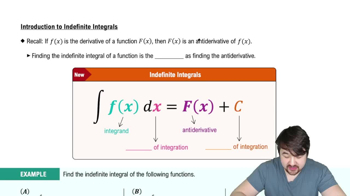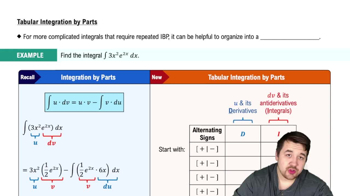Given that
Table of contents
- 0. Functions7h 54m
- Introduction to Functions16m
- Piecewise Functions10m
- Properties of Functions9m
- Common Functions1h 8m
- Transformations5m
- Combining Functions27m
- Exponent rules32m
- Exponential Functions28m
- Logarithmic Functions24m
- Properties of Logarithms36m
- Exponential & Logarithmic Equations35m
- Introduction to Trigonometric Functions38m
- Graphs of Trigonometric Functions44m
- Trigonometric Identities47m
- Inverse Trigonometric Functions48m
- 1. Limits and Continuity2h 2m
- 2. Intro to Derivatives1h 33m
- 3. Techniques of Differentiation3h 18m
- 4. Applications of Derivatives2h 38m
- 5. Graphical Applications of Derivatives6h 2m
- 6. Derivatives of Inverse, Exponential, & Logarithmic Functions2h 37m
- 7. Antiderivatives & Indefinite Integrals1h 26m
- 8. Definite Integrals4h 44m
- 9. Graphical Applications of Integrals2h 27m
- 10. Physics Applications of Integrals 3h 16m
- 11. Integrals of Inverse, Exponential, & Logarithmic Functions2h 34m
- 12. Techniques of Integration7h 41m
- 13. Intro to Differential Equations2h 55m
- 14. Sequences & Series5h 36m
- 15. Power Series2h 19m
- 16. Parametric Equations & Polar Coordinates7h 58m
12. Techniques of Integration
Integration by Parts
Problem 8.7.28
Textbook Question
7–40. Table look-up integrals Use a table of integrals to evaluate the following indefinite integrals. Some of the integrals require preliminary work, such as completing the square or changing variables, before they can be found in a table.
28. ∫ ln² x dx
 Verified step by step guidance
Verified step by step guidance1
Step 1: Recognize that the integral ∫ ln²(x) dx involves a logarithmic function squared. To solve this, we can use a table of integrals that provides a formula for ∫ ln²(x) dx.
Step 2: Recall the formula from the table of integrals: ∫ ln²(x) dx = x * ln²(x) - 2x * ln(x) + 2x + C, where C is the constant of integration.
Step 3: Verify that the formula matches the structure of the given integral. If necessary, confirm the derivation of the formula using integration by parts.
Step 4: Substitute the formula directly into the integral, ensuring that all terms are expressed in terms of x.
Step 5: Simplify the expression obtained from the formula, and include the constant of integration (C) to represent the indefinite integral.
 Verified video answer for a similar problem:
Verified video answer for a similar problem:This video solution was recommended by our tutors as helpful for the problem above
Video duration:
6mPlay a video:
Was this helpful?
Key Concepts
Here are the essential concepts you must grasp in order to answer the question correctly.
Indefinite Integrals
Indefinite integrals represent a family of functions whose derivative is the integrand. They are expressed with the integral sign and do not have specified limits. The result includes a constant of integration, denoted as 'C', reflecting the fact that there are infinitely many antiderivatives differing by a constant.
Recommended video:

Introduction to Indefinite Integrals
Integration Techniques
Various techniques are employed to evaluate integrals, especially when they cannot be solved directly. Common methods include substitution, integration by parts, and completing the square. These techniques transform the integral into a more manageable form, allowing for easier application of integral tables or direct integration.
Recommended video:

Integration by Parts for Definite Integrals
Integral Tables
Integral tables are collections of pre-calculated integrals that provide quick references for evaluating common integrals. They list integrals alongside their corresponding results, often requiring the user to manipulate the integrand into a suitable form. Familiarity with these tables can significantly expedite the integration process, especially for complex functions.
Recommended video:

Tabular Integration by Parts

 8:30m
8:30mWatch next
Master Introduction to Integration by Parts with a bite sized video explanation from Patrick
Start learningRelated Videos
Related Practice
Multiple Choice
9
views
